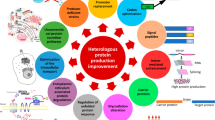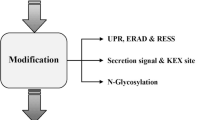Abstract
Filamentous fungi are widely used for the production of homologous and heterologous proteins but, compared to homologous proteins, the levels of production of heterologous proteins are usually low. During the last 5 years, the levels of production of heterologous proteins have been drastically improved by fusing the corresponding gene to the 3' end of a homologous gene, encoding a well-secreted protein such as glucoamylase. Nevertheless, little research has been carried out to determine the limitations that hamper heterologous protein production. Recently we have carried out a detailed analysis of the levels of production of several proteins and glucoamylase fusion proteins in defined recombinant Aspergillus awamori strains. In this review we will focus on the use of filamentous fungi for the production of heterologous, especially non-fungal, proteins. In particular, the effect of gene-fusion strategies will be reviewed. Furthermore, the remaining limitations in heterologous protein production and suggestions for improvement strategies for overproduction of these protein will be discussed.
Similar content being viewed by others
Author information
Authors and Affiliations
Additional information
Received: 5 July 1996 / Accepted: 6 September 1996
Rights and permissions
About this article
Cite this article
Gouka, R., Punt, P. & van den Hondel, C. Efficient production of secreted proteins by Aspergillus : progress, limitations and prospects. Appl Microbiol Biotechnol 47, 1–11 (1997). https://doi.org/10.1007/s002530050880
Issue Date:
DOI: https://doi.org/10.1007/s002530050880




